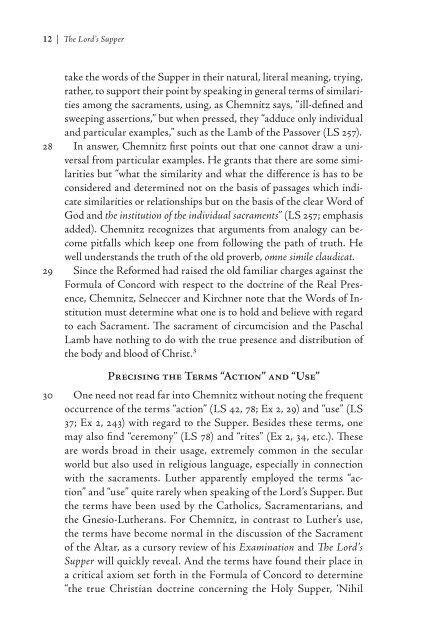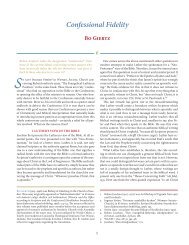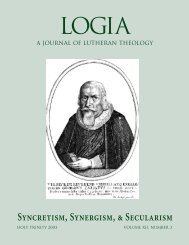The Lord's Supper in the Theology of Martin Chemnitz Bjarne - Logia
The Lord's Supper in the Theology of Martin Chemnitz Bjarne - Logia
The Lord's Supper in the Theology of Martin Chemnitz Bjarne - Logia
You also want an ePaper? Increase the reach of your titles
YUMPU automatically turns print PDFs into web optimized ePapers that Google loves.
| <strong>The</strong> Lord’s <strong>Supper</strong><br />
take <strong>the</strong> words <strong>of</strong> <strong>the</strong> <strong>Supper</strong> <strong>in</strong> <strong>the</strong>ir natural, literal mean<strong>in</strong>g, try<strong>in</strong>g,<br />
ra<strong>the</strong>r, to support <strong>the</strong>ir po<strong>in</strong>t by speak<strong>in</strong>g <strong>in</strong> general terms <strong>of</strong> similarities<br />
among <strong>the</strong> sacraments, us<strong>in</strong>g, as <strong>Chemnitz</strong> says, “ill-def<strong>in</strong>ed and<br />
sweep<strong>in</strong>g assertions,” but when pressed, <strong>the</strong>y “adduce only <strong>in</strong>dividual<br />
and particular examples,” such as <strong>the</strong> Lamb <strong>of</strong> <strong>the</strong> Passover (LS 257).<br />
28 In answer, <strong>Chemnitz</strong> first po<strong>in</strong>ts out that one cannot draw a universal<br />
from particular examples. He grants that <strong>the</strong>re are some similarities<br />
but “what <strong>the</strong> similarity and what <strong>the</strong> difference is has to be<br />
considered and determ<strong>in</strong>ed not on <strong>the</strong> basis <strong>of</strong> passages which <strong>in</strong>dicate<br />
similarities or relationships but on <strong>the</strong> basis <strong>of</strong> <strong>the</strong> clear Word <strong>of</strong><br />
God and <strong>the</strong> <strong>in</strong>stitution <strong>of</strong> <strong>the</strong> <strong>in</strong>dividual sacraments” (LS 257; emphasis<br />
added). <strong>Chemnitz</strong> recognizes that arguments from analogy can become<br />
pitfalls which keep one from follow<strong>in</strong>g <strong>the</strong> path <strong>of</strong> truth. He<br />
well understands <strong>the</strong> truth <strong>of</strong> <strong>the</strong> old proverb, omne simile claudicat.<br />
29 S<strong>in</strong>ce <strong>the</strong> Reformed had raised <strong>the</strong> old familiar charges aga<strong>in</strong>st <strong>the</strong><br />
Formula <strong>of</strong> Concord with respect to <strong>the</strong> doctr<strong>in</strong>e <strong>of</strong> <strong>the</strong> Real Presence,<br />
<strong>Chemnitz</strong>, Selneccer and Kirchner note that <strong>the</strong> Words <strong>of</strong> Institution<br />
must determ<strong>in</strong>e what one is to hold and believe with regard<br />
to each Sacrament. <strong>The</strong> sacrament <strong>of</strong> circumcision and <strong>the</strong> Paschal<br />
Lamb have noth<strong>in</strong>g to do with <strong>the</strong> true presence and distribution <strong>of</strong><br />
<strong>the</strong> body and blood <strong>of</strong> Christ. 3<br />
Precis<strong>in</strong>g <strong>the</strong> terms “Action” and “Use”<br />
30 One need not read far <strong>in</strong>to <strong>Chemnitz</strong> without not<strong>in</strong>g <strong>the</strong> frequent<br />
occurrence <strong>of</strong> <strong>the</strong> terms “action” (LS 42, 78; Ex 2, 29) and “use” (LS<br />
37; Ex 2, 243) with regard to <strong>the</strong> <strong>Supper</strong>. Besides <strong>the</strong>se terms, one<br />
may also f<strong>in</strong>d “ceremony” (LS 78) and “rites” (Ex 2, 34, etc.). <strong>The</strong>se<br />
are words broad <strong>in</strong> <strong>the</strong>ir usage, extremely common <strong>in</strong> <strong>the</strong> secular<br />
world but also used <strong>in</strong> religious language, especially <strong>in</strong> connection<br />
with <strong>the</strong> sacraments. Lu<strong>the</strong>r apparently employed <strong>the</strong> terms “action”<br />
and “use” quite rarely when speak<strong>in</strong>g <strong>of</strong> <strong>the</strong> Lord’s <strong>Supper</strong>. But<br />
<strong>the</strong> terms have been used by <strong>the</strong> Catholics, Sacramentarians, and<br />
<strong>the</strong> Gnesio-Lu<strong>the</strong>rans. For <strong>Chemnitz</strong>, <strong>in</strong> contrast to Lu<strong>the</strong>r’s use,<br />
<strong>the</strong> terms have become normal <strong>in</strong> <strong>the</strong> discussion <strong>of</strong> <strong>the</strong> Sacrament<br />
<strong>of</strong> <strong>the</strong> Altar, as a cursory review <strong>of</strong> his Exam<strong>in</strong>ation and <strong>The</strong> Lord’s<br />
<strong>Supper</strong> will quickly reveal. And <strong>the</strong> terms have found <strong>the</strong>ir place <strong>in</strong><br />
a critical axiom set forth <strong>in</strong> <strong>the</strong> Formula <strong>of</strong> Concord to determ<strong>in</strong>e<br />
“<strong>the</strong> true Christian doctr<strong>in</strong>e concern<strong>in</strong>g <strong>the</strong> Holy <strong>Supper</strong>, ‘Nihil




